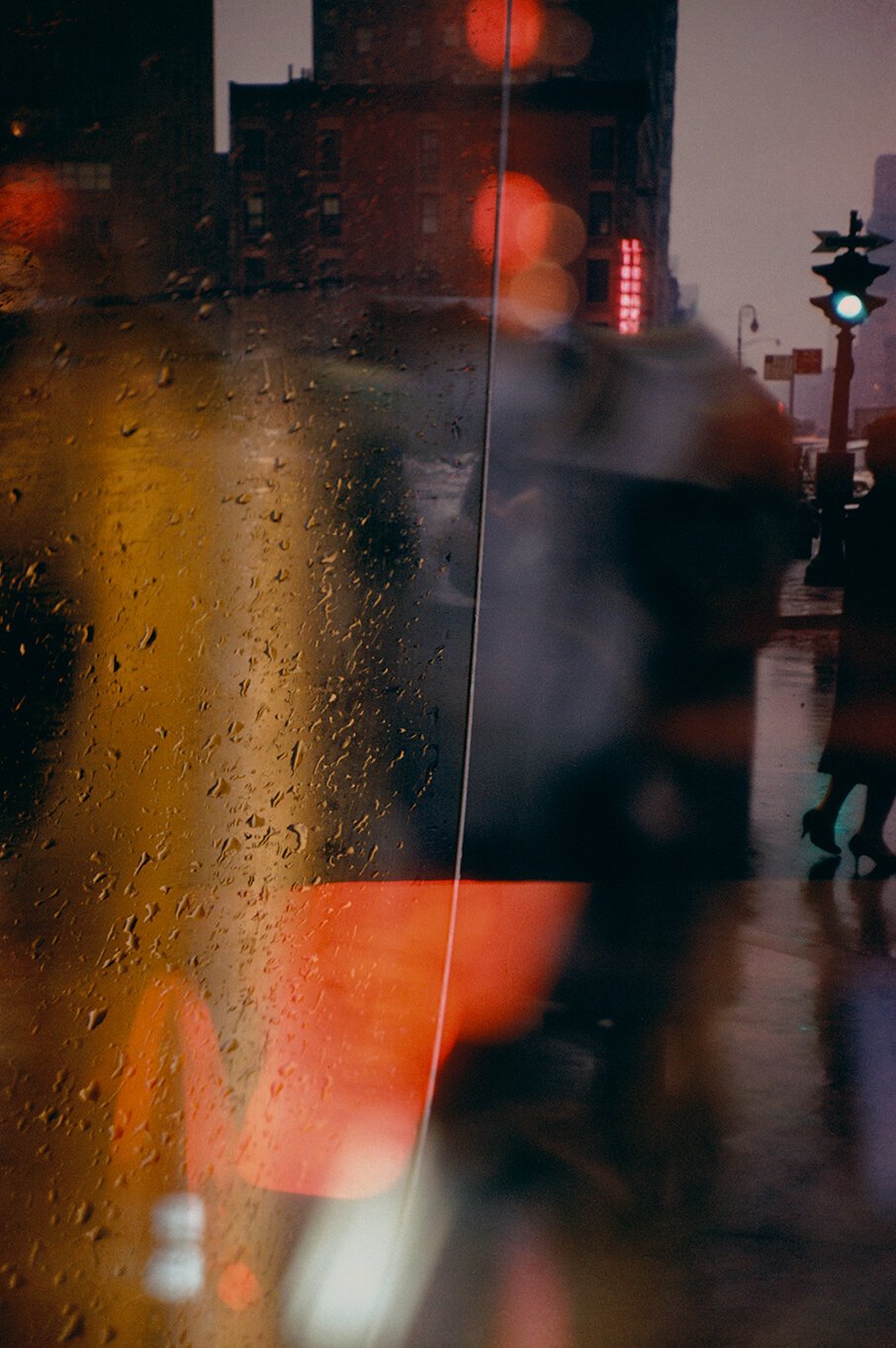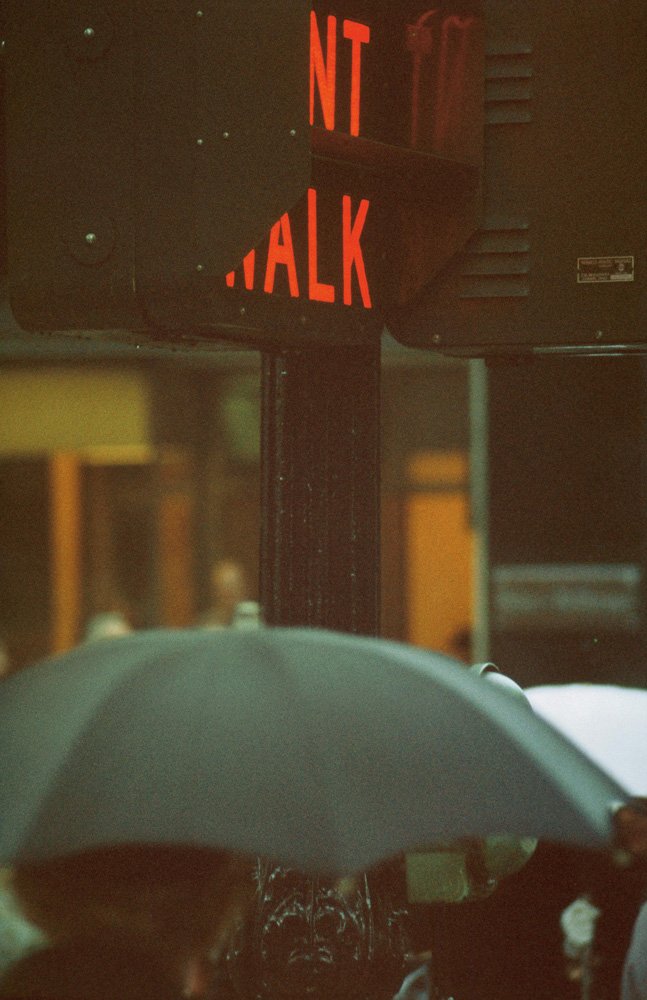
Of Compression and The Infinite: Metaphysics of Saul Leiter and Sean Bonney
by Allie McKean
Saul Leiter was an American photographer renowned for the art of the colored photograph, and for the poetic and expressionistic extractions of the 1950s urban mundane. Historically, street photographers are very fond of the wide angle lens—a lens that filters as much of the image in as possible, even from a close distance—and, of course they are! We want all the dazzling spectacles around our subjects as streets chime full of life; we want the tufts of smog, the loose dog and french fries, graying of trash cans, the blur of the biker, the crescendoing elbows of street lamps, the rightness that faces of buildings hold as they sturdy behind our subjects. Leiter, instead, chose the telephoto lens: a lens with a much closer focal point that almost climbs into the image itself. It cuts close up against the subject, compressing the action. Leiter’s evocation of the mundane derives from the photograph’s compression. His image is the geography of a moment mapped out: color, light, geometrics, and shadow. It sleeves an intimacy we’d miss in a glance, and brings us to the moment our eyes, might otherwise, dart away from. To see the back end of light, the end of a breath. How much do we grieve what is lost in the telephoto lens? Compression is a way to bring someone closer to what is already not in view. The compressed image contains not only what is, but also what isn’t.
Bonney, in the opening of Letters Against the Firmament, mentions Aime Cesaire's conception of the surrealist image as a means of greeting the “infinite” (12). And what is representative of the infinite? Well, for one, we can look to the camera lens—always a circle, never any other shape. And the cones in the eyes, the retina, the iris… “The scraped wound—we live inside it like fossilized, vivisected mice'' (13) as Bonney would say. We are always compressing infinities of light through a lens, sound through waves, shapes through a circle—and we are always compressing infinities of intangibilities through speech. Through the sound of speech.
Photography is always how I’ve been able to render the utility of compression, but Bonney’s propensity of the “global harmonic”, which evokes the likeness of Federico Garcia Lorca’s duende and Nathaniel Mackey’s exploration of Cante Moro, illustrates compression in “the deep song” embedded in every piece and unpiece of our connected universe. Mackey writes that the sonic concept of Cante Moro “bespeaks the presence and persistence of the otherwise excluded, the otherwise expelled” and makes space for the unimagined. Bonney renders the choral attributions to a deeper global hum, the forces of history and future married—furnishing the present. It’s much deeper than the image. The image is above us, an exterior property. Sound is a more interior force, and much more possessive than an image. As sound waves are physicality, the burning hum of rage that is material. In reality, it’s the music that we are dealing with, not what's actually visible.
Saul Leiter, Don’t Walk (1952)
As Bonney evokes the “global harmonic” throughout Letters Against The Firmament, it might be worthwhile to dissect the anatomy of a harmonic to see why this is perhaps a useful metaphor for unveiling the layers of the global systems of strife and power. A harmonic, though typically one note taking the space of a beat in music (or moment), becomes a polyvalent object. Using this diagram, we can see how the tonality of a harmonic register gets shaped inside one note. What does a harmonic sound like? Great question. I’d describe a harmonic as “the rainbow” of sound. If you’ve ever listened to “Simulation Swarm” by Big Thief, Adrienne Lenker, the band’s lead vocalist and guitarist, plays two harmonics during the guitar solos that occur throughout the song. It's the moment the guitar chokes into a pang that creates vibrant and multicolored frequencies in just one small resonate half beat. This is produced by Lenker swiftly (and oh so gently) tapping and then releasing the string on the metal bar of the fret itself. Sonically, it’s a little gift wrapped in tinsel to the ear. For visual reference, in the diagram, the red line is exactly how a string takes physical shape against the metal fret when being played. When Lenker’s finger is tapped onto the metal fret, the raised metal conducts sound down both ends of the guitar string. The string is able to vibrate its entire length as opposed to only half, as a guitar string is typically sandwiched into the wooden neck between the two frets, barring it from ringing out at the upper end of guitar neck. A harmonic contains octaves, a tone vibrated at double/triple… (to possibly infinity) its frequency, conversing and diverging from one another at different contact points. Here, in a harmonic, it's all compressed into one sound. In short, there’s a lot going on in a harmonic, compression at its most absolute, which is what makes it a perfect vessel and metaphor for Bonney to attempt to convey the insurmountability of the current political and social systems of late-stage capitalism.
Poetics is sound and written word compressed together in a similar delivery. Bonney’s poetic project unpacks the utility of the compression of rage, and in many ways aligns itself with the project of surrealism, to better navigate the complex fissures that compression faces us with. On one hand, compression is an incredibly reductive methodology for understanding anything, but at the same time, it's all we have. The encouragement Bonney has for us to get up into that compression and dial in to where political meaning is created inside the center is compelling. A great success of Bonney’s work is that through the compression of language and sonic intensity, it also represents what is unsaid, untruthed, unheard.
Works Cited
Bonney, Sean. Letters Against The Firmament. Enitharmon Editions, 2016.
García Lorca, Federico.“Theory and Play of The Duende”. In Search of Duende, translated by Christopher Maurer, New Directions Press, 1998, pg 48-62.
Mackey, Nathaniel. “Cante Moro.” BLACKOUT ((poetry & politics)), https://my-blackout.com/2018/09/27/nathaniel-mackey-cante-moro/.
Allie McKean is a poet in the MFA for Poets & Writers at The University of Massachusetts-Amherst. She works for the Juniper Summer Writing Institute and teaches college composition. Her chapbook Gutter Ball (2024) is out from Distance No Object.

